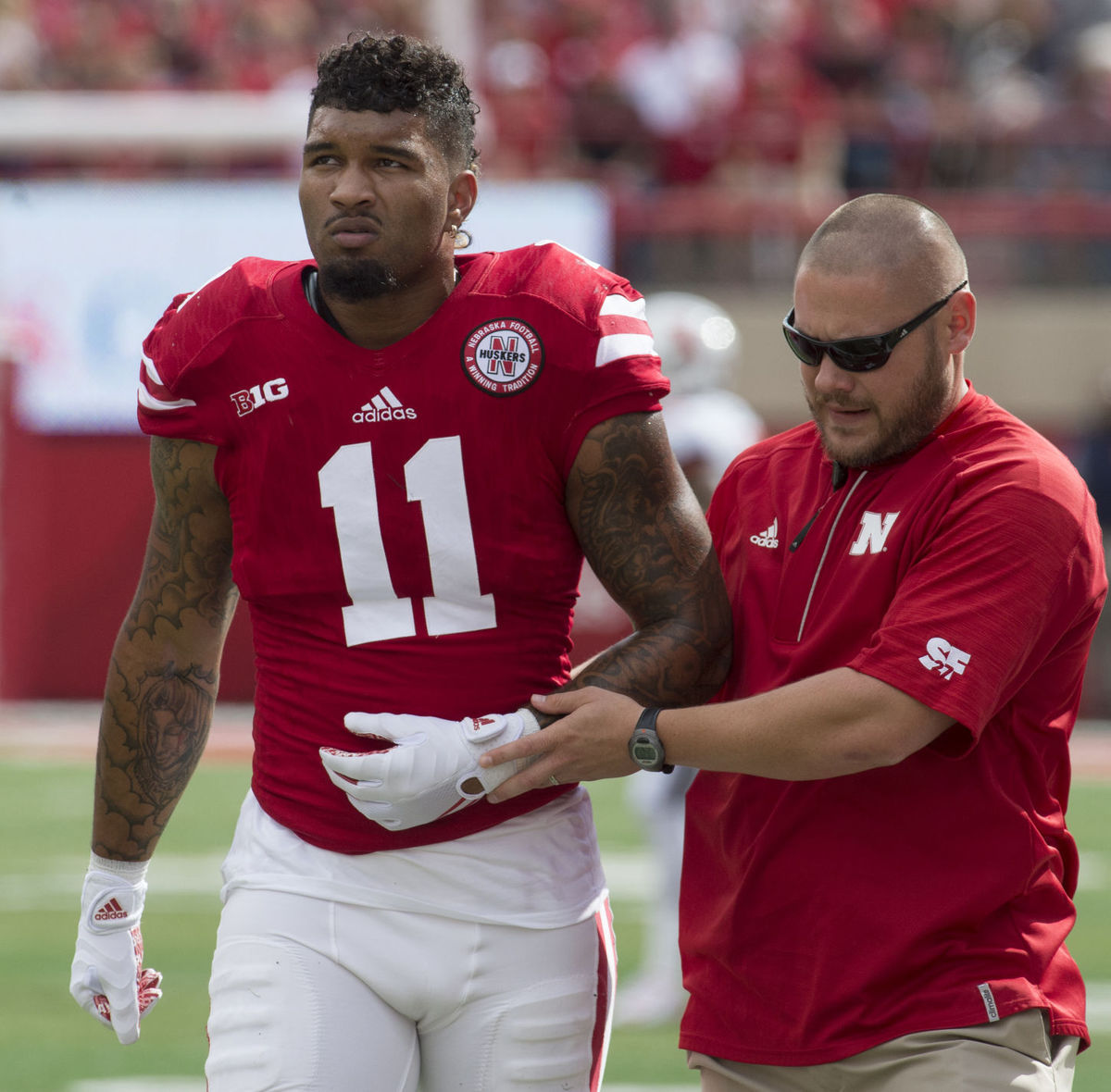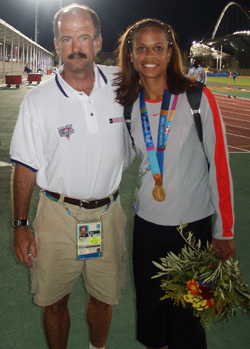
Last Sunday night, a true blue Big Red pioneer received the first-ever Dick Herman Lifetime Achievement Award at Lincoln’s downtown Lied Center for Performing Arts.
Legendary and longtime Nebraska Athletic Trainer George ‘Sully’ Sullivan, 88, walked across the Lied Center’s grand stage, flanked by brothers and former Husker defenders Clete Pillen and Jim Pillen, who represented thousands of Husker football players that Sully served, treated, counseled and loved in his 41-year Husker career.
Reinforcing that star-studded escort were Heisman Trophy winner Johnny Rodgers, Outland Trophy winner Rich Glover and first-team All-American Daryl White.
“George Sullivan had an impact in my life that’s been immeasurable as I look back on it,” said Clete Pillen, who three years ago was named the sixth best Blackshirt in Husker history. Clete’s 30 tackles in Nebraska’s 14-10 win over Oklahoma State 40 years ago still stands as a school record, and you may want to read this link to understand why Sully ranks Clete as one of the three toughest players he ever treated.
“George provided me the mentoring, the support and that tough love to be the player that I needed to be and the person that I am today,” said Clete, who partners with fellow Blackshirt and brother Jim in a family-owned farming operation near their hometown of Columbus, Neb.
The Pillens join a legion of supporters for Sully, who suited up for Nebraska football in 1947 and 1948 after serving his country in World War II. The force that defined Sullivan was his bachelor’s and master’s degrees from the University of Nebraska and his physical therapy degree from the University of Iowa.

Sullivan’s Influence on Nebraska Football Pervasive and Worthy of Recognition
The essence of Sullivan’s overall impact on Nebraska Football is pervasive and explains why he became the inaugural recipient of the Dick Herman Lifetime Achievement Award.
A year ago, to celebrate the 25th anniversary of Nebraska’s annual student-athlete recognition event, Tom Osborne presented Herman with the highest award. Since Herman’s passing, a new lifetime achievement award carries his name and recognizes his entire family for their unwavering commitment and passion to honor student-athletes who have excelled academically, athletically and in the community.
Sullivan was the players’ friend. “He was always the guy who you could go into his office and talk,” said Pat Clare, one of Nebraska’s first Academic All-Americans who was voted a tri-captain and later became Nebraska’s longtime orthopedic surgeon. “George did it all. He was totally dedicated to the University of Nebraska and its athletes. He was always available. He was there early and he was there late. If you got hurt, he was always helping you out.
“Something else crossed my mind the other day,” Clare said. “George was way ahead of this concussion game. He used to carry these little white capsules below the bill of his cap. They were ammonia capsules and if you got dinged a little bit and you were kind of seeing stars, George could come out and put that little capsule in your nose and you could jump right up and be back playing in no time at all.”
Sunday’s comments inside the Lied Center triggered some laughter intermixed with candor. “George was just a great guy,” Clare said. “I certainly care for him just like everyone else. He was an amazing guy, a smart guy and always on top of things. I love him.”

Head Athletic Trainer Weber: All of George’s Accolades Over the Years Totally Deserved
So does Jerry Weber, Nebraska’s associate director of athletic medicine and head athletic trainer. Weber cherishes his opportunity to work with Sullivan and learn from him. “All of the accolades George has received over the years are totally deserved,” Weber said, pointing out that Sullivan taught him as much about life as he did about athletic training.
First and foremost, Sullivan took care of players. He treated them correctly. Weber said Sully always made sure they came first – ahead of the program, ahead of their sport, even ahead of their coaches.
Weber also remembers the outpouring of emotion when Sully retired two decades ago. “Athletes came back to Lincoln from all over the world to honor George at the Legion Club,” Weber said. “Come hell or high water, those guys weren’t going to miss thanking George for what he’s done. He was one of the true pioneers in his field.”
Tom Osborne told me something that the media and most people don’t understand – how much appreciation the players have for their trainers. “They have a lot of loyalty to their coaches, but an even greater affection for the people who took care of them,” he said. “They’d say things to George that they wouldn’t say to a coach. Trainers don’t make you run wind sprints or demote you to third team. George listened and always had a good feel for what players were thinking. He didn’t betray confidences, but if he felt the attitude wasn’t right or something was out of kilter, he’d let you know. That input was always very valuable. That’s why he was in our staff meetings every morning at 7. We trusted him just like a coach. He did a great job.”
Did we mention Sully’s influence in the field that became his chosen profession?
Returning to his native Nebraska in 1953, Sullivan split time as chief physical therapist for the University of Nebraska Health Center, caring for the general UNL population, as well as Husker student-athletes. In 1977, Sullivan was named the Huskers’ head trainer, a title he kept until his retirement in 1995.

Sullivan’s Training Expertise Became Synonymous with Student-Athlete Welfare/Safety
During his tenure in Lincoln, pioneer became the most appropriate one-word job description. Athletic training also became synonymous with student-athlete welfare and safety. Sullivan(pictured above with his family) was masterful in providing expertise and medical care. He showed genuine concern for the welfare of thousands of student-athletes at the same time he was mentoring countless professionals.
Charlie McBride, the defensive coordinator for three Nebraska national championship football teams, emphasizes that Sullivan not only took care of players, but also their families. “My wife remembers when one of my kids got hurt and he took the bus to go see George about it,” McBride said.
“George didn’t accept a lot of excuses that the players always had,” McBride said. “I know how they feel. When I had a knee operation, George worked on it, so I could get rid of all the scar tissue. It was kind of hurting, so he told me to grab a hold and push hard. He pushed that thing all the way down to my tail and I didn’t know whether I was going into heaven or hell at that particular time.
“George thought about everybody and never thought about himself,” McBride said. “He was a disciplinarian about kids coming in for treatment. He got more players on the field than you could ever think about, and it was through his knowledge, his kindness and kids wanting to do it just for George.
“In all my time at Nebraska, I never heard one bad thing about George Sullivan,” McBride said. “He was pretty good on the field, too. He let the officials know what he thought. Those were exciting times when you were on the field with George. You know he’s on your side.”

Devaney, Osborne Respected Sullivan; Student-Athletes that Sully Treated Adored Him
Known for his incredible work-ethic, inspirational leadership and positive nature, Sully was a servant to all student-athletes and an extension of the coaching staff, earning the ultimate respect from Hall-of-Fame coaches Bob Devaneyand Tom Osborne, not to mention the adoration from the student-athletes he treated.
In 2008, the George Sullivan Endowed Scholarship was established to support a football student-athlete in pursuit of a career related to medicine. Todd Peterson was the inaugural recipient in 2008, followed by Adi Kunalic (2009), Sean Fisher (2010, 2011 and 2012), Jake Long (2013), Johnny Stanton (2014), De’Mornay Pierson-El (2015) and Chris Weber (2016).
In 1951, Sullivan was among those who signed the original document that launched the National Athletic Trainers Association (NATA). “When they needed to elevate to a professional level, George helped develop the first national exams to certify and license athletic trainers,” Weber said. “He was also among the first nationally to use his skills as a physical therapist to enhance his expertise as an athletic trainer.”
Nebraska strength and conditioning pioneer Boyd Epley learned from Sullivan, a mentor who helped him form the National Strength and Conditioning Association. “George advised me to contact NATA,” Epley said, “and he invited our strength coaches to come to their national conference in Las Vegas
“Because George saw an opportunity, we were able to take steps and make it all happen,” Epley said. “We ended up having separate organizations, but George was very helpful in having the right people support us, so we could move forward. It gave us an opportunity in June to bring strength coaches together at their national conference and then host our first-ever national conference in Lincoln in late July, 1978. Bob Devaney was the first featured speaker, and everything took off from there. George was very well respected and very well connected nationally. His help was absolutely critical for us.”

Nebraska Coach, Player, Medical Colleague: Sullivan a Giver, Role Model, Inspiration
Through the years, Dan Kendig, Nebraska’s longtime women’s gymnastics coach, said Sullivan’s impact was big. “Just ask all the student-athletes he’s handled over the years and the way they speak about him,” Kendig said. “That tells you everything right there. He’s just a giver. You can’t be in the position he was in if you aren’t a giver.”
Ask former Nebraska quarterback Clete Blakeman about the impact Sullivan had on the Husker who became the head referee in the 2016 Super Bowl. “From day one as a freshman to now, George has been an influence,” Blakeman said. “He was the guy who wasn’t your coach and wasn’t your strength guy, but if you had a question, he knew the answer or someone who had the answer.
“All the memories I have of George are fond memories, forever and ever,” Blakeman said. “He taped my ankles every day. George was my guy, day in and day out. I learned a lot from him. When you get five to 10 minutes like that every day for five years, you better get smarter, especially when you have the pleasure to listen to George. He was a great man, and you could always trust him.”
No one knows that better than Lonnie Albers, Nebraska’s associate athletic director for athletic medicine since 1995 and a member of Nebraska Athletics since 1985.
“When I think of George (pictured above receiving an honorary varsity letter N from Nebraska Director of Athletics Shawn Eichorst), character is the first word that comes to mind,” Albers said. “He was so dedicated to the people he worked with. His relationships and his ability to bind people together reflected his character.
“George had a giant smile and everything about him exudes character,” Albers said. “He would help anybody, and he’s very deserving to receive the Herman Award.”
Albers often reflects on Sully’s contributions to the care of all Nebraska student-athletes.
With a genuine smile and a tender heart, Albers shared why Sullivan will always be part of his professional life. “I have the honor to see his national athletic trainers’ Hall of Fame picture on the wall inside the stadium every time I leave my office,” Albers said. “That’s a great way to end the day.”
Send a comment to ryork@huskers.com (Please include city, state)
Follow Randy on Twitter at www.twitter.com/RandyYorkNsider
CLICK HERE FOR ORIGINAL ARTICLE




